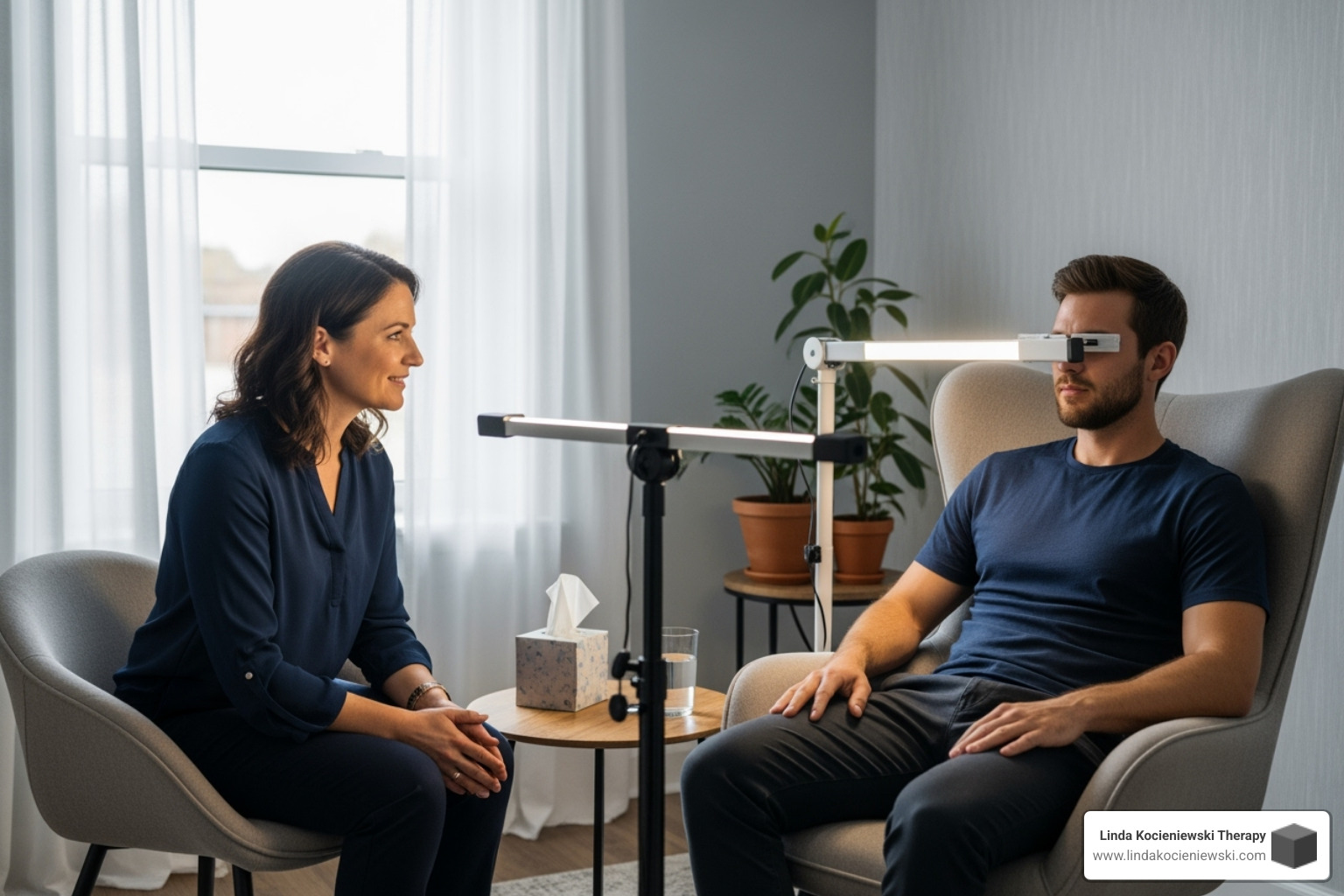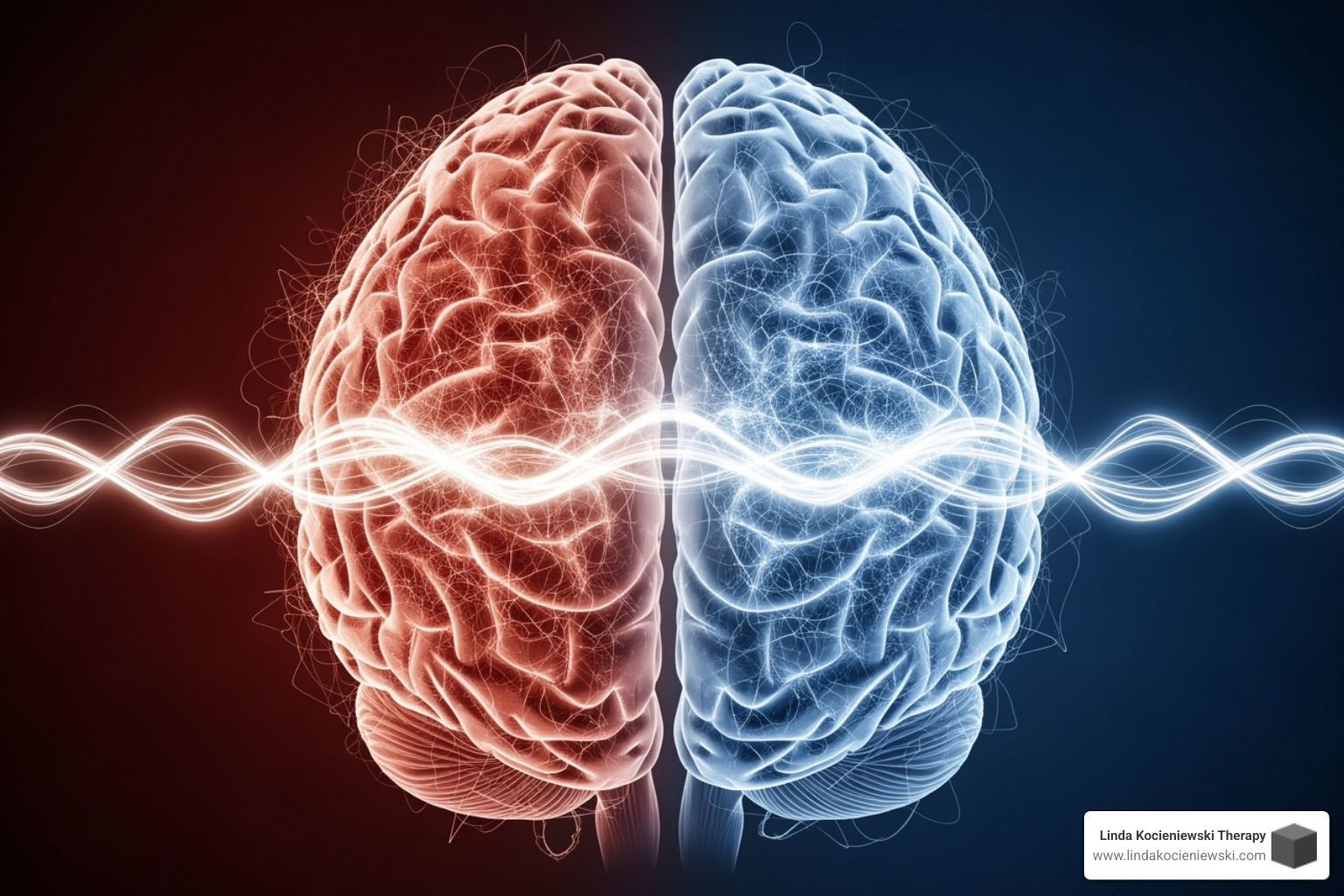Is EMDR Therapy Right for You? A Deep Dive for Adults, Teens, and Beyond
Understanding What EMDR Therapy Can Do for Your Healing Journey

EMDR therapy for adults is a proven psychotherapy approach designed to help you process traumatic memories and emotional wounds that can keep you stuck in patterns of anxiety, depression, and self-doubt.
If you've tried traditional talk therapy but still feel weighed down by past experiences, you're not alone. Many adults find themselves repeating old patterns, struggling with persistent anxiety, or feeling held back by events from their past. The good news is that your brain has a natural ability to heal from psychological trauma, much like your body heals from physical wounds. Sometimes, that process just needs the right support to get unstuck.
EMDR, which stands for Eye Movement Desensitization and Reprocessing, is a structured therapy that uses bilateral stimulation—typically eye movements, tones, or gentle tapping—to help your brain reprocess traumatic memories that have been "frozen in time." This allows your mind to digest difficult experiences and file them away as resolved memories rather than ongoing sources of distress.
Recognized by the World Health Organization, the American Psychiatric Association, and the Department of Veterans Affairs, EMDR is a trusted and effective treatment. Research shows that 84-90% of single-trauma victims no longer have PTSD after just three sessions. It's a path forward that honors both your strength and your readiness to heal.
As Linda Kocieniewski, a Certified EMDR Therapist and EMDRIA Approved Consultant, I have spent many years helping adults heal from trauma. Through EMDR therapy for adults and intensive EMDR sessions, I can help you create the life you've always dreamed of.
Understanding EMDR: A Breakthrough Approach to Healing

EMDR therapy for adults stands for Eye Movement Desensitization and Reprocessing. While the name might sound complex, the core concept is beautifully simple: your brain already knows how to heal, and sometimes it just needs the right conditions to do its job.
This approach was developed in 1987 by Dr. Francine Shapiro, who finded that certain eye movements seemed to reduce the intensity of her own disturbing thoughts. This observation led to years of research and the development of the structured, eight-phase therapy used today.
At the heart of EMDR is the Adaptive Information Processing (AIP) model, which explains how trauma memories can get "stuck." When an overwhelming event occurs, the brain's natural processing system can get flooded. Instead of being filed away as a completed experience, the traumatic memory is stored with all its raw intensity—the sights, sounds, feelings, and body sensations—as if it's still happening.
This is why a specific smell or sound can trigger a powerful emotional or physical reaction years later. The past feels like the present because the memory was never properly processed.
EMDR therapy for adults creates the conditions for your brain to finish that processing. During a session, you'll briefly focus on the stuck memory while experiencing bilateral stimulation. This usually involves following my finger with your eyes, but we can also use auditory tones or gentle tapping on your hands. This back-and-forth stimulation activates both sides of your brain, similar to what happens during REM sleep when your mind processes daily events.
This dual attention—focusing on the memory while also engaging in the present-moment stimulation—open ups your brain's natural healing capacity. It's about reprocessing, not reliving. The goal isn't to erase the memory, but to change how your brain stores it. After successful processing, you'll still remember what happened, but it will feel like an event from the past, free from the intense emotional charge and physical reactions.
For more detailed information, the EMDR International Association offers a comprehensive resource: What is EMDR Therapy?.
Is EMDR Right for You? Conditions Treated and Who Can Benefit
EMDR therapy is widely recognized for its effectiveness in treating a broad spectrum of conditions rooted in distressing life experiences. While it first gained prominence for treating Post-Traumatic Stress Disorder (PTSD), its applications extend much further, addressing the underlying memories and beliefs that fuel many psychological challenges. If you're an adult seeking profound healing and lasting change, EMDR might be an excellent fit for you.
EMDR therapy can help individuals struggling with:
- PTSD and Trauma: As a first-line treatment for symptoms like flashbacks, nightmares, and hypervigilance, as well as for any disturbing life experience that continues to cause distress.
- Anxiety, Panic Attacks, and Phobias: Many anxiety disorders are fueled by past experiences that taught the brain to perceive danger. EMDR targets these root memories, helping to desensitize the triggers that cause panic, social anxiety, or specific phobias.
- Depression: Particularly when depressive symptoms are linked to unresolved past events, grief, or negative self-beliefs. EMDR can reprocess the memories that reinforce feelings of hopelessness or worthlessness, creating space for a more positive self-concept.
- Childhood Abuse and Neglect: Reprocessing these foundational traumas that profoundly impact adult functioning and self-esteem.
- Grief and Loss: When grief becomes complicated, EMDR can help process the traumatic aspects of a loss, allowing the natural grieving process to proceed.
- Chronic Pain and Somatic Issues: EMDR can help reduce the intensity of chronic pain by addressing the emotional and stress-related components stored in the nervous system.
Exploring EMDR Therapy for Adults with Complex Trauma
For many adults, trauma isn't a single event but a series of prolonged experiences, often in childhood. This is known as complex trauma (C-PTSD) and can include developmental trauma and neglect. These early experiences shape our core beliefs about ourselves and others, forming our attachment style. When our early environment was unsafe, we may develop insecure attachment patterns that lead to difficulties with trust, intimacy, and emotional regulation in adulthood.
Healing these deep-seated wounds requires a nuanced approach. Attachment-focused EMDR is invaluable here, as it works to heal the underlying attachment wounds, not just isolated memories. The process prioritizes building your internal resources and coping skills to ensure you feel safe before reprocessing. We may spend significant time in the preparation phase, helping you develop internal safety and self-compassion. Our work is always trauma-informed, moving at a pace that feels comfortable, with the goal of helping you build an "earned secure attachment"—an internalized sense of safety and connection you can carry into your life and relationships.
Beyond Trauma: Using EMDR for Personal Growth and Confidence
EMDR is also a powerful tool for personal growth, helping to overcome limiting beliefs not tied to a major Trauma. It can effectively address issues like performance anxiety, a persistent inner critic, or imposter syndrome by reprocessing the smaller, everyday memories that instilled feelings of inadequacy. Perhaps it was a teacher's critical comment or a minor social rejection. These "small-t" traumas can accumulate, creating a negative filter. By targeting and changing the meaning of these events, EMDR can dismantle these limiting beliefs at their source, opening up your potential and helping you feel more confident and alive.
What to Expect: Your Journey Through the 8 Phases of EMDR
Starting EMDR therapy for adults is a structured, eight-phase journey designed to ensure your safety while creating space for profound healing. It's a carefully designed roadmap that honors your courage and your brain's innate wisdom. My approach is highly personalized; while the phases provide a framework, we move at your pace, and you are always in control.

Phase 1 & 2: History-Taking and Preparation
The foundation of our work is a trusting therapeutic relationship. In our initial sessions, I'll learn your story and goals to create a clear treatment plan. This phase is also dedicated to preparation, a critical part of the process. I'll explain how EMDR works and we'll practice the bilateral stimulation (BLS) techniques to find what feels most comfortable.
A key part of this is resourcing—equipping you with a robust toolkit of coping skills. We'll develop your Safe/Calm Place, a personalized visualization to access for grounding. We may also use other exercises like the Container, where you visualize a secure place to hold distressing material between sessions. We only move forward when you have a solid toolkit and feel completely ready. For those with complex trauma, we may spend more time building these essential resources, as your readiness is the priority.
Phase 3-6: Assessment, Desensitization, Installation, and Body Scan
These four phases are the heart of the reprocessing work. Here’s a brief example for an adult with social anxiety rooted in a childhood memory of being laughed at in class:
Phase 3: Assessment. We choose the specific target memory. I'll ask you to identify the most disturbing image, the negative cognition (NC) it reinforces (e.g., "I am worthless"), and the desired positive cognition (PC) (e.g., "I have inherent worth"). We then measure how disturbing the memory feels (Subjective Units of Disturbance, or SUDs) and how true the positive belief feels (Validity of Cognition, or VoC).
Phase 4: Desensitization. This is where the BLS begins. I'll ask you to hold the target in mind while you follow my fingers with your eyes (or use other BLS) for a short set. Afterward, I'll ask, "What do you notice now?" You simply report whatever comes to mind as your brain makes new connections. You might notice the image fading or a shift in emotion. We continue with more sets of BLS, and most people find the SUDs level decreases rapidly as the memory loses its emotional charge.
Phase 5: Installation. Once the distress has dropped to a 0 or 1, we shift focus to strengthening your positive belief. I'll ask you to hold the original memory and your PC in mind as we do more sets of BLS to "install" this new, adaptive belief until it feels fully true.
Phase 6: Body Scan. Finally, I'll ask you to hold the memory and the positive belief in mind and mentally scan your body for any residual tension. If any remains, we'll use BLS to process it until your body feels calm and clear.
Phase 7 & 8: Closure and Re-evaluation
The final phases focus on integration and lasting progress. Closure occurs at the end of every session to ensure you leave feeling grounded. If a memory isn't fully processed, I'll guide you through a resourcing technique to feel contained until our next meeting. Re-evaluation begins each new session. We'll check on previously processed memories to ensure the positive changes have been maintained. This is often a moment to celebrate your progress. This ongoing assessment also helps us identify any new targets, ensuring our work remains responsive to your needs.
Why Choose EMDR Therapy for Adults? Efficacy, Speed, and Recognition
When you're ready to heal, you have many therapy options. What makes EMDR therapy for adults stand out is its unique approach, remarkable results, and backing by decades of research and the world's leading health organizations.
How EMDR Differs from Traditional Talk Therapy
While talk therapy is invaluable, it often focuses on changing thoughts and narratives, engaging the "thinking brain." EMDR takes a different approach by addressing how experiences are stored somatically and emotionally in the brain and body. It requires less detailed talking about the trauma and more time actively processing it, which many find less overwhelming. Trauma isn't just a story; it's a physiological reality in the nervous system. EMDR is a body-based (somatic) approach that directly engages these experiences to release stuck traumatic energy. The use of dual attention—focusing on a memory while simultaneously engaged in the present via bilateral stimulation—creates a sense of safety that makes processing more manageable. EMDR focuses on changing the memory networks themselves, altering the emotional impact at its source.
The Neuroscience Behind EMDR: How Does It Work in the Brain?
While the exact mechanisms are still being researched, neuroscientists have compelling theories about why EMDR is so effective. One leading theory is that bilateral stimulation (BLS) taxes the brain's working memory. By focusing on a traumatic memory while also performing eye movements, you overload your working memory, making the memory less vivid and emotional. This allows it to be reconsolidated (re-stored) in a more adaptive way. Neurological imaging also shows that EMDR appears to decrease activity in the amygdala (the brain's fear center) and increase activity in the prefrontal cortex (the region for emotional regulation). EMDR helps calm the brain's alarm system and allows the thinking part of the brain to understand that the danger is over. The process is also thought to mimic the neurological activity of REM sleep, where our brains naturally process daily events.
The Evidence Behind EMDR: What the Research Shows
The effectiveness of EMDR is supported by more than 24 randomized controlled trials. The results are compelling: 84% to 90% of single-trauma survivors no longer meet the criteria for PTSD after just three 90-minute EMDR sessions. A study of individuals with multiple traumas found that 77% no longer had PTSD after only six 50-minute sessions. Research consistently shows that EMDR can be both faster and more effective than other trauma-focused therapies. Even combat veterans showed remarkable improvement, with 77% being free of PTSD symptoms after 12 sessions.

Recognition by Major Health Organizations
EMDR has earned recognition from leading mental health and medical organizations globally. The World Health Organization (WHO), the American Psychiatric Association (APA), and the US Department of Veterans Affairs and Department of Defense all endorse EMDR as a first-line treatment for trauma. This widespread approval reflects the therapy's reliability.
For those interested in the science, the American Psychological Association provides comprehensive information on scientific research on EMDR therapy.
How Long Does EMDR Treatment Take?
While every healing journey is personal, EMDR is noted for its efficiency. For a single traumatic memory, processing often occurs within one to three sessions. For most adults, a full course of EMDR therapy for adults involves 6 to 12 sessions. For complex or developmental trauma, healing may take longer, as these wounds require careful work in the preparation and resourcing phases. Even in these cases, EMDR is often more efficient than other approaches. For those who wish to accelerate their healing, I also offer EMDR Intensives, which allow for more immersive work in a shorter timeframe.
Taking the Next Step on Your Healing Journey
Recognizing that you don’t have to carry the weight of the past forever is a powerful first step. EMDR therapy offers a path forward that is fundamentally different from just managing symptoms—it addresses the root cause.
What makes EMDR therapy for adults such a powerful choice?
- It is evidence-based, backed by solid research and endorsed by major health organizations worldwide.
- It is often efficient, with many people experiencing meaningful change in a matter of weeks or months, not years.
- It is transformative, reprocessing the memories that created anxiety or depression in the first place.
What to Expect When We Begin
The first step is simple: we start with a complimentary Zoom consultation so we can talk face-to-face about what brings you to therapy and determine whether we feel like a good fit. If you decide you’d like to move forward, we’ll explore what you hope to gain from therapy and how you want to feel and live better.
Ongoing Care and Support
Once care is established, we’ll meet on a consistent weekly basis—either in my comfortable Midtown Manhattan office or online anywhere in New York State. During these sessions I provide proven, attachment-focused EMDR therapy (and EMDR Intensives when appropriate) in a safe, collaborative space. Together, we’ll track your progress, adjust the pacing as needed, and make sure you’re receiving exactly what you need to move forward in your healing journey.
Most importantly, your EMDR journey will be personalized to your unique history and goals. There is no cookie-cutter approach; your healing process will unfold at your own pace and in your own way.
Healing is possible. Your brain has an incredible capacity to recover, and sometimes it simply needs the right support to become unstuck. As a solo therapist dedicated to deeper trauma work, my mission is to provide that support so you can foster improved well-being and a happier, more empowered life.
Conclusion
The journey through understanding EMDR therapy for adults reveals a remarkable truth: healing from trauma and life's most challenging experiences is possible, and it doesn't have to take decades. This innovative approach works directly with your brain's natural capacity to transform how painful memories affect your daily life.
EMDR is powerful because it addresses the root cause of your distress. Whether you're carrying the weight of childhood trauma or feeling stuck in patterns of anxiety, EMDR provides a structured, evidence-based path forward. The process helps your brain reprocess "frozen" memories, allowing you to move from feeling overwhelmed by the past to feeling empowered in the present. This efficiency doesn't mean the work is rushed; it reflects how effectively EMDR works with your brain's own healing system.
Perhaps most importantly, your healing journey is entirely unique. The therapy adapts to meet you exactly where you are, providing safety and predictability while honoring the personal nature of your experience. As Linda Kocieniewski, LCSW, I have witnessed countless adults reclaim their lives through this transformative work. From my practice in Midtown Manhattan and through online sessions across New York State, I use an attachment-focused model to help people move from just surviving to truly thriving.
If you feel stuck and believe you are capable of more joy and peace, EMDR might be the key. Your capacity to heal is already within you. Ready to explore if EMDR therapy for adults is your path forward?
I invite you to schedule your complimentary Zoom consultation with me today. Together, we can explore how EMDR can help you create a life where your past informs your strength rather than limiting your future.